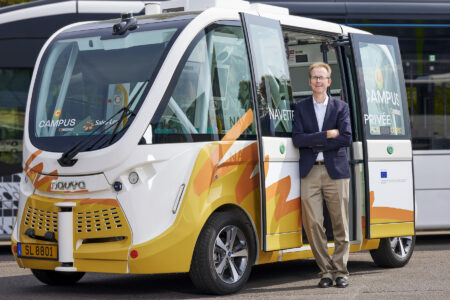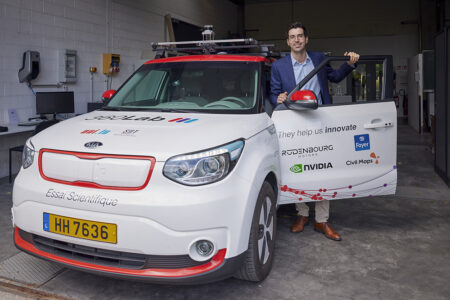 Although it will still take years before we see driverless cars on our roads, they are no longer science fiction. “Autonomous vehicles will be part of the transport solutions of the future, not least in public transport,” says Georges Hilbert, General Director of Sales-Lentz, one of Luxembourg’s largest providers of mobility services and public transport. “The integration of automation systems into conventional vehicles will also considerably improve the safety of mobility. This is one of the main reasons why we decided to get involved in helping mature autonomous technologies.”
Although it will still take years before we see driverless cars on our roads, they are no longer science fiction. “Autonomous vehicles will be part of the transport solutions of the future, not least in public transport,” says Georges Hilbert, General Director of Sales-Lentz, one of Luxembourg’s largest providers of mobility services and public transport. “The integration of automation systems into conventional vehicles will also considerably improve the safety of mobility. This is one of the main reasons why we decided to get involved in helping mature autonomous technologies.”
Real-life tests of self-driving vehicles
Sales-Lentz introduced Luxembourg’s first 100% electric, self-driving shuttle buses in 2018 as part of its journey towards zero emission that began almost 15 years ago. “We started to cooperate with Navya, a French manufacturer of autonomous vehicles, and joined a research project funded by the EU to test-run their autonomous shuttles in a real-life environment,” says Mr Hilbert.
We joined a research project funded by the EU to test-run autonomous vehicles in a real-life environment.
The company currently operates four shuttles running in city centres and an industrial area. Its role is to test the self-driving vehicles on public roads in all types of conditions, and provide feedback to project partners – manufacturers, software developers and researchers dealing with technological, legal, regulatory and safety matters. “We have already transported tens of thousands of passengers and are amazed by the positive response. Our surveys indicate an acceptance level of 99%.”
Mobility on demand
Current legislation imposes the constant presence of an operator on board the shuttles. “Training these operators, who need a completely different skill set compared to conventional bus drivers, is a major part of deployment,” Mr Hilbert explains. “Operators will always be needed, but in the future, they will oversee the shuttles from an office instead of inside the bus.”
This is a new phase in smart mobility.
A recent step forward for the company is making its regular shuttle service in the pedestrian zone of Esch-sur-Alzette, Luxembourg’s second biggest city, available on demand. Using a mobile phone app, passengers can pre-book a trip and receive immediate information about when they will be picked up and how many seats are available in the shuttle. At the moment, the service runs on one predefined line, but the area covered by the on-demand service will soon be extended. “This is a new phase in smart mobility,” Mr Hilbert points out.
Developing autonomous systems
 While Sales-Lentz provides concrete input from an operator’s point of view, researchers at the University of Luxembourg’s Interdisciplinary Centre for Security, Reliability and Trust (SnT) develop technology for autonomous driving. “Autonomous systems and the internet of things is one of our strategic research areas,” explains Senior Research Scientist Raphaël Frank who heads the SnT’s 360Lab. “My research laboratory heavily focuses on high-definition digital maps needed for autonomous driving, and on merging them with the dynamic context surrounding the vehicles via sensor fusion, localisation and so on. Other labs work on topics such as inter-vehicle connectivity, the use of computer vision systems and the development of secure, resilient self-driving systems.”
While Sales-Lentz provides concrete input from an operator’s point of view, researchers at the University of Luxembourg’s Interdisciplinary Centre for Security, Reliability and Trust (SnT) develop technology for autonomous driving. “Autonomous systems and the internet of things is one of our strategic research areas,” explains Senior Research Scientist Raphaël Frank who heads the SnT’s 360Lab. “My research laboratory heavily focuses on high-definition digital maps needed for autonomous driving, and on merging them with the dynamic context surrounding the vehicles via sensor fusion, localisation and so on. Other labs work on topics such as inter-vehicle connectivity, the use of computer vision systems and the development of secure, resilient self-driving systems.”
My research laboratory heavily focuses on high-definition digital maps needed for autonomous vehicles.
Cooperation with industry is at the heart of the centre’s activities. “Our work on high-definition maps is done in partnership with American company Civil Maps that came to Luxembourg a few years ago,” says Professor Frank. “We also work with an insurance company, Foyer Assurances, on future telematics insurance products for self-driving vehicles.”
His research group has built its own autonomous car, used as a research platform for demonstration purposes. “A few months ago, we successfully test-drove the car on public roads for the first time. This showcased that we have technological solutions that enable autonomous driving in a real-life environment.”
Photos: © Luxinnovation/Eric Devillet

